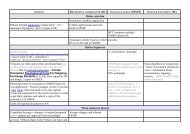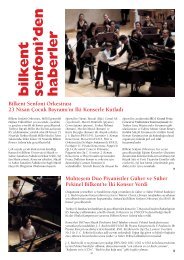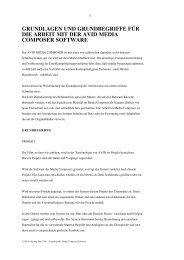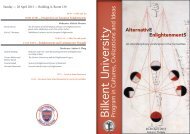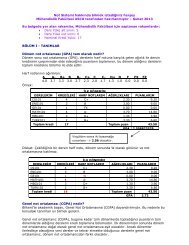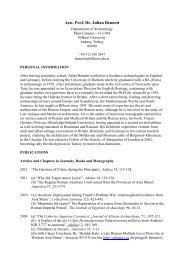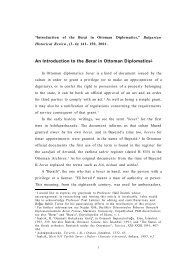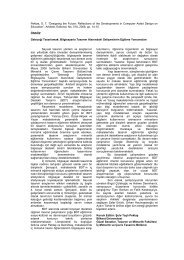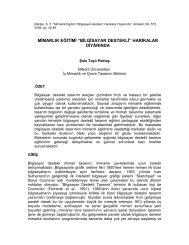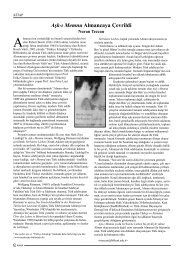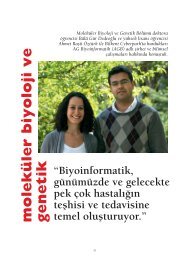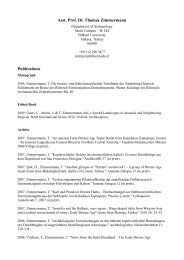German mathematicians in exile in Turkey ... - Bilkent University
German mathematicians in exile in Turkey ... - Bilkent University
German mathematicians in exile in Turkey ... - Bilkent University
You also want an ePaper? Increase the reach of your titles
YUMPU automatically turns print PDFs into web optimized ePapers that Google loves.
<strong>German</strong> <strong>mathematicians</strong> <strong>in</strong> <strong>exile</strong> <strong>in</strong> <strong>Turkey</strong> 443<br />
Faculty of Sciences of Istanbul <strong>University</strong> [Geir<strong>in</strong>ger and Kosswig [21], Appendix B]. 34 And<br />
the third paper [Geir<strong>in</strong>ger [19], Appendix B] was a purely theoretical one on the probability<br />
of arbitrarily l<strong>in</strong>ked events, which found its place <strong>in</strong> her widely discussed paper [Geir<strong>in</strong>ger,<br />
1944]. 35 These three papers paved the way for a number of others, enabl<strong>in</strong>g Geir<strong>in</strong>ger to<br />
pursue her research program fruitfully <strong>in</strong> the US. As a result, she was able to derive a system<br />
of recurrence formulae that yield the distribution of genotypes <strong>in</strong> the nth generation if<br />
their distribution <strong>in</strong> the previous generation and the “l<strong>in</strong>kage distribution” are known and<br />
show how the distribution <strong>in</strong> the nth generation can be computed from the 0th generation<br />
us<strong>in</strong>g those formulae. The l<strong>in</strong>kage distribution was directly related to the probability of<br />
arbitrarily l<strong>in</strong>ked events, hence the importance of [Geir<strong>in</strong>ger [19], Appendix B]. 36<br />
Interest<strong>in</strong>gly, Prager too became <strong>in</strong>trigued by the idea of apply<strong>in</strong>g mathematics to genetics<br />
and co-authored a paper with the geneticist Alfred Heilbronn (Prager and Heilbronn [8],<br />
Appendix A). 37 We have then every reason to believe that Geir<strong>in</strong>ger’s and Prager’s <strong>in</strong>terest<br />
<strong>in</strong> this topic was k<strong>in</strong>dled as a result of their <strong>in</strong>teractions with their colleagues Heilbronn,<br />
Kosswig, Caspari and Braun who were teach<strong>in</strong>g at Istanbul <strong>University</strong> dur<strong>in</strong>g the same<br />
period.<br />
It is also worth mention<strong>in</strong>g the contributions of von Mises, Prager, and Geir<strong>in</strong>ger to the<br />
Revue de la Faculté des Sciences l’Universite d’Istanbul, Nouvelle Serie, the journal of the<br />
Faculty of Sciences of Istanbul <strong>University</strong>. This journal began its publication <strong>in</strong> 1935,<br />
and its first editorial committee consisted of Prager, physicists Marcel Fouche and Fahir<br />
Yenicßag˘, and Sßevket Aziz Kansu, a professor of anthropology. It had a multi-language policy<br />
of publication and was divided <strong>in</strong>to Series A and B <strong>in</strong> 1940, where the former published<br />
articles exclusively <strong>in</strong> the fields of mathematics, physics and chemistry [ _ Icßen, 1982, 3–4]. The<br />
34<br />
Kosswig (1903–82) and Geir<strong>in</strong>ger were colleagues <strong>in</strong> the Faculty of Sciences dur<strong>in</strong>g the same<br />
period. Kosswig studied at the <strong>University</strong> of Berl<strong>in</strong> and received his “Habilitation” at Münster<br />
<strong>University</strong> <strong>in</strong> 1927. Before jo<strong>in</strong><strong>in</strong>g Istanbul <strong>University</strong> <strong>in</strong> 1936, he was a professor of genetics at<br />
Braunschweig Technical <strong>University</strong>. He was appo<strong>in</strong>ted as the director of the Institute of Zoology at<br />
Istanbul <strong>University</strong> <strong>in</strong> 1937 and taught there until 1955. He had about a hundred publications and<br />
directed n<strong>in</strong>e Ph.D. theses. He was awarded an honorary doctorate by Istanbul <strong>University</strong> for his<br />
contributions. Ishakog˘lu-Kadıog˘lu _ [1998, 263–269] conta<strong>in</strong>s valuable and detailed <strong>in</strong>formation<br />
about his scholarly works and activities <strong>in</strong> <strong>Turkey</strong>. For a biographical sketch, see also the entry <strong>in</strong><br />
tr.wikipedia.org/wiki/Curt_Kosswig.<br />
35<br />
This is Geir<strong>in</strong>ger’s most cited publication. Accord<strong>in</strong>g to the Web of Science, there were 137<br />
references to it as of 30 November 2011, the next most cited papers are the 1948, 1949 and 1945<br />
publications with 21, 20 and 15 citations respectively as of the same date, and they still get cited,<br />
especially <strong>in</strong> papers <strong>in</strong> the theory of genetic algorithms.<br />
36<br />
Geir<strong>in</strong>ger’s other papers on genetics <strong>in</strong>clude [Geir<strong>in</strong>ger, 1945a, 1945b, 1948a, 1948b, 1949]. For a<br />
full list, see [B<strong>in</strong>der, 1992].<br />
37<br />
At the time Heilbronn (1885–1961) was the director of the Institute of Pharmacobotany and<br />
Genetics <strong>in</strong> the Faculty of Sciences. He had received his Ph.D. <strong>in</strong> the field of botany from the<br />
<strong>University</strong> of Münster <strong>in</strong> 1921 and became the director of the Institute of Genetics there <strong>in</strong> 1923. He<br />
jo<strong>in</strong>ed <strong>University</strong> of Istanbul <strong>in</strong> 1933 and taught there until 1960. He is credited with start<strong>in</strong>g the<br />
modern <strong>in</strong>struction and research <strong>in</strong> genetics <strong>in</strong> <strong>Turkey</strong>. Like Kosswig, he too was very productive,<br />
publish<strong>in</strong>g about 25 articles and five books. He directed eleven doctoral theses. Heilbronn and<br />
Kosswig also co-authored several articles on the pr<strong>in</strong>ciples of genetics. For a very <strong>in</strong>formative<br />
documentation of Heilbronn’s life and work, see [ _ Ishakog˘lu-Kadıog˘lu, 1998, 250–255]. See also<br />
[Demiriz, 1982] for the role Heilbronn and Kosswig played <strong>in</strong> the development of genetics and<br />
pharmacobotany <strong>in</strong> <strong>Turkey</strong>.



